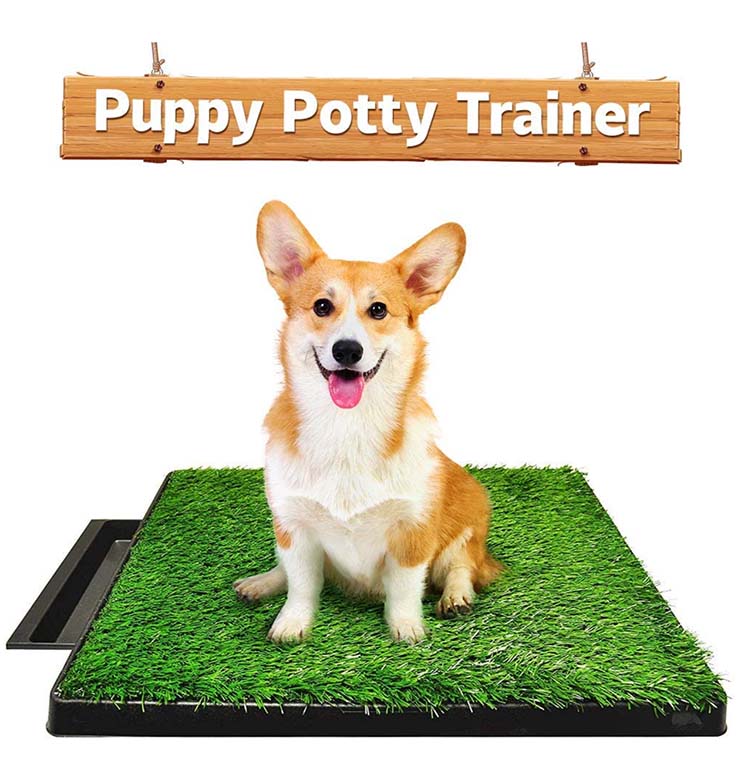Disclosure: Dogs of Australia is reader-supported. When you buy through links on our site, we sometimes earn an affiliate commission at no added cost to you. Learn more
Bringing a puppy home is an exciting time, but those first few weeks you and your new dog spend together will likely also be unnerving.
Potty training will be high up on the list of things to get on top of straight away, and many dog owners decide to use Puppy Pads to toilet train their puppies.
Puppy training pads have many benefits; one of them is that you can literally set them up anywhere. Even if you don’t have access to a garden, you can still toilet train your puppy.
Toilet training takes time and patience, so with a new dog, you want to get started on toilet training straight away. It’s much easier to teach a puppy a new behaviour than having to un-teach a wrongly learned behaviour.
Table of Contents
ToggleShould I Use Pee Pads For My Puppy?
Many people ask themselves if they should use Pee Pads for their puppy. Opinions on this topic vary, and some people don’t need to use Pee Pads for their puppy. That said, there are several reasons why you might want to use them.
5 Reasons Why People Use Puppy Training Pads
1. Bladder Control
Many new dog owners get their new dog when they’re just over 8 weeks old. On average, a puppy can control their bladder one hour for every month of age. That makes 2-3 hours at the time you get your puppy.
So, unless you took time off work for your new puppy or have someone check in on your puppy regularly, it can really help to use Pee Pads.
2. Convenience
Pee Pads make it easy to clean up after your dog, as you can simply pick them up and toss away.
3. Garden Accessibility
Many dog owners don’t have easy access to a garden, so it’s just easier to toilet train your puppy on Puppy Pads first.
4. Health Reasons
Pee Pads are also a good option for dogs who can’t go outside for health reasons. For example, if your puppy hasn’t had all his vaccinations just yet and you don’t have easy access to a private garden.
5. Weather friendly
For all those times where the weather outside is just so awful that neither you nor your dog will want to go outside, Pee Pads can give your dog an indoor toilet option.
What Is The Best Puppy Toilet Training Pad?
There are several Puppy Training Pad’s that you can buy and we summarised them for you below.
Reusable (Washable) Puppy Pads
Reusable Puppy Pads, also known as washable puppy pads, are better for the environment and they will also save you money in the long run.

Single-Use Puppy Pee Pads
As the same suggests, these type of pee pads are single-use, and you throw them away after your puppy has done its business on it.

Artificial Grass Puppy Pads
If you prefer to teach your dog to do their business on a grassy surface, you could consider getting a puppy pad with artificial grass on top.

Real Grass Puppy Pads
You can teach your puppy to do their business on real grass only by purchasing actual grass puppy pads. Please note that they need regular replacement and aren’t a one-off purchase.

Are Puppy Pads Safe?
Puppy training pads are generally safe for dogs to use, but they’re not indestructible. If you don’t provide your puppy with enough toys as well as spending time playing with your puppy, there’s a risk of your dog becoming bored and using the Puppy Pads as a toy.
Shredded Pee Pads are no fun to clean up, so make sure you provide your puppy with enough opportunities for socialisation, play time, training and mental stimulation (don’t over-do it though, rest time is important too!).
If your dog is shredding the Puppy Pads, there’s also a risk of them eating their Puppy Pads.
Is It Dangerous For Dogs To Eat Puppy Pads?
Yes, it can be dangerous for your dog to eat Puppy Pads. If it looks like your puppy ate a significant amount of their Puppy Pad, it’s best to call your vet.
What Happens If A Dog Eats A Puppy Pad?
Well, think about it this way: Puppy Pads have been designed to be absorbent. If they land in your puppy’s belly, they could absorb fluids from the gastrointestinal tract and grow in size. If they grow bigger, they might get stuck in your puppy’s body on the way out, and that’s not good.
How Do You Get A Puppy To Go On A Puppy Pad?
There’s an easy way to get a puppy on a Puppy Pad. Most new dog owners will set up a dedicated space for their puppy in the living room.
For example, this can be a crate that’s surrounded by a playpen. In doing this, you provide your puppy with a safe place to sleep in, as well as a restricted area to move around, play, and eat in.
Dogs naturally don’t want to soil the area where they sleep and eat, so put the Puppy Pad on the opposite side of the playpen from where your puppy’s crate and food bowl is.
Using Positive Training To Get Your Puppy Used To A Puppy Pad
Use positive training to get your puppy on a puppy pad. Observe your puppy, and when your puppy looks like they’re about to do their business, put your dog on the Puppy Pad and say your cue word, such as ‘go potty’.
You may need to do this several times before your puppy will actually do their business on the Puppy Pad. Don’t get angry when your puppy does their business elsewhere. You don’t want your puppy to become fearful and stressed.
Stay persistent, and when your puppy finally goes potty on the Puppy Pad reward heavily. Check out this article if you want more in-depth steps: Puppy Housetraining – Victorial Stilwell
Note that dogs tend to pee in the same place again and again. Therefore, it’s important to quickly clean up and eliminate the smell in areas where accidents happened.
Urine has a strong smell of ammonia, so be careful not to use cleaning products that contain ammonia. You could use white vinegar or an enzymatic cleaner.
Do Puppy Pads Attract Dogs?
Some puppy training pad brands contain an attractant which can encourage your dog to use them. They’re usually ammonia, pheromones, or grass scents. Attractants can be useful at the start of toilet training your puppy.
Should You Rub A Dog’s Nose In Pee?
You should absolutely not rub a dog’s nose in pee. Use positive training when toilet training your puppy. There’s no need to get angry or punish your puppy for having an accident. Puppies don’t do it on purpose, and they don’t understand that they’re doing something wrong.
If anything, you’ll confuse your puppy, and that can make it even worse. Remember that puppies are babies, and we don’t punish our human babies for such accidents either.
If you catch your puppy ‘in action’ of an accident, the best way to deal with it is to interrupt the behaviour. You can make a sudden noise such a clap, followed by saying the word ‘no’. Note that you want to startle your puppy, not scare them.
Then, quickly put your puppy on the Puppy Pad. If your puppy continues doing his business on the Puppy Pad, praise heavily.
How Long Should You Use Puppy Pads?
How long you should use Puppy Pads depends on the reason you’re using Puppy Pads in the first place. If you used Puppy Pads because you have no access to a garden and your puppy wasn’t fully vaccinated, you could start the transition period as soon as it’s safe for your puppy to go outside.
If you used Puppy Pads for convenience, many people stop using Puppy Pads once their puppy can sleep through the night without needing to relieve themselves.
How Do You Transition A Puppy From Puppy Pads To Outside?
You don’t have to stop using Puppy Pads abruptly, but rather transition your puppy to do their business outside. T
his is as simple as taking the Potty Pads away for a few hours every day, and when you notice that your puppy is looking for a place to pee, take your puppy outside to do their business there. Depending on how you go, increase the time with no access to Puppy Pads


























